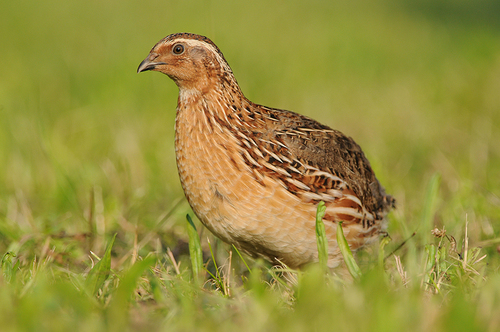
Common Quail
The Common Quail (*Coturnix coturnix*) is a small, ground-dwelling bird in the pheasant family, renowned for its migratory prowess and distinctive call. It plays a vital role in grassland and agricultural ecosystems as both a seed disperser and prey for larger predators. Historically, the Common Quail has been a significant game bird across its range, and it holds cultural importance in various regions, often appearing in folklore and traditional cuisine. Unlike many game birds, it undertakes long-distance migrations.
16-18 cm
Length
32-35 cm
Wingspan
Least Concern
Conservation Status
Distribution
The Common Quail has a wide distribution, breeding across Europe, Asia, and parts of Africa. It migrates south to sub-Saharan Africa, the Indian subcontinent, and Southeast Asia for the winter. Altitudinal range varies from sea level to mountainous regions, up to around 2,000 meters.
Lifespan
Typically 2-3 years in the wild, but can live longer in captivity.
Common Quail's Habitat
Habitat Types
Grasslands, Agricultural fields, Steppes, Meadows
Climate Zones
Temperate, Tropical, Subtropical
Adaptations
Their cryptic plumage provides excellent camouflage in dense vegetation. Strong legs allow for efficient running and scratching for food on the ground. They are adapted to survive in relatively dry environments.
Variations
Several subspecies are recognized, differing slightly in plumage coloration and size, such as *C. c. coturnix* (European Quail) and *C. c. japonica* (Japanese Quail, now often considered a separate species *Coturnix japonica*).
Appearance
Breeding Plumage
Plumage is generally similar year-round, with subtle differences. Breeding males may have a more defined throat pattern.
Seasonal Feather Changes
Minor seasonal variations, primarily in the intensity of coloration.
Sex Based Plumage Differences
Males have a black anchor-shaped marking on the throat, which is less distinct or absent in females. Females are generally more mottled.
Notable Features
Cryptic brown and buff plumage with streaks and bars, Short, rounded wings, Short tail
Diet and Feeding
Primary Foods
Seeds, Insects, Small invertebrates, Green plant material
Foraging Behavior
Forages on the ground, scratching and pecking for food. Often feeds in small groups, especially during migration.
Specializations
Strong legs and feet for scratching the ground. A relatively short, stout beak is well-suited for picking up seeds and insects.
Seasonal Diet Variations
Diet shifts seasonally depending on food availability. Insects are more prevalent in the diet during the breeding season, providing protein for chicks. Seeds become more important in the non-breeding season.
Behavior
Social Structure
Generally solitary or found in small groups (coveys), except during migration when larger flocks may form.
Communication
Distinctive 'wet-my-lips' call of the male, Soft contact calls between individuals, Alarm calls when threatened
Migration
Common Quails are highly migratory, undertaking long-distance flights between breeding and wintering grounds. They often fly at night, navigating using a combination of celestial cues and the Earth's magnetic field.
Territorial or Group Behaviors
Males are territorial during the breeding season, defending their area from rivals. Outside of breeding, they are generally less aggressive.
Conservation
Threats
Habitat loss and degradation due to agricultural intensification, Pesticide use, Hunting pressure in some regions, Climate change (affecting migration patterns and breeding success)
Protection Programs
Monitoring of populations, Habitat restoration and management, Sustainable hunting regulations in some areas
Local National Laws
Protected under various national and international laws, including the Agreement on the Conservation of African-Eurasian Migratory Waterbirds (AEWA).
Population Trend
Decreasing
Population Estimates
Global population estimated to be between 17,800,000 - 41,800,000 individuals.
Interesting Facts
They are capable of sustained flight over long distances.
Despite their small size, Common Quails migrate thousands of kilometers, crossing large bodies of water and deserts.
They are one of the smallest game birds in Europe.
Their small size and elusive nature make them a challenging quarry for hunters.
Quail eggs are a delicacy in many cultures.
Quail eggs are smaller than the eggs from chickens
Faqs about Common Quail
Are Common Quails related to chickens?
Yes, both Common Quails and chickens belong to the pheasant family (Phasianidae).
Can Common Quails fly?
Yes, they are strong fliers, especially during migration. However, they often prefer to run and hide in vegetation when threatened.
What is the lifespan of a Common Quail?
Typically 2-3 years in the wild, but they can live longer in captivity.
Are common quails endangered?
No. They are listed as 'Least Concern' by the IUCN.
Copyright @ Nature Style Limited. All Rights Reserved.
 English
English